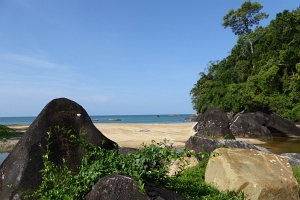Inhalt
1. Lebendfotos
1.1. Falter
1: Thailand, Provinz Phang Nga, Lam Kaen, ca. 10 m, 18. November 2014 (det. & fot.: Peter Ginzinger)Forum
2: Kambodscha, Siem Reap, Angkor Wat, ca. 30 m, 10. Dezember 2015 (det. (cf.) & fot.: Peter Ginzinger)Forum
3: Malaysia, Tapah, 10. Mai 2016 (det. & fot.: Regine Hakenbeck)
4: Thailand, Insel Ko Kut, See mit Bachbett, 40 m, 21. April 2023 (det. & fot.: Gerald Sutter), conf. Dominik HoferForum
1.2. Ssp. goberus
1: Singapur, Botanischer Garten, 21. Juli 2014 (det. & fot.: Wolfgang Hackbusch)Forum
2. Diagnose
2.1. Erstbeschreibung
1: Godart ([1824]: 656) [nach Copyright-freiem Scan auf www.biodiversitylibrary.org]
3. Biologie
3.1. Habitat
1-2: Thailand, Provinz Phang Nga, Lam Kaen, ca. 10 m, 11. & 13. November 2014 (fot.: Peter Ginzinger)Forum
4. Weitere Informationen
4.1. Andere Kombinationen
- Polyommatus emolus Godart, [1824] [Originalkombination]
4.2. Synonyme
- Lampides balliston Hübner, [1823] [Synonym nach funet.fi]
- Lycaenesthes bengalensis Moore, [1866] [Synonym nach funet.fi]
4.3. Unterarten
- Anthene emolus modesta (Staudinger, 1889) [Unterart nach funet.fi]
- Anthene emolus andamanicus (Fruhstorfer, 1916) [Unterart nach funet.fi]
- Anthene emolus goberus (Fruhstorfer, 1916) [Unterart nach funet.fi]
- Anthene emolus javanus (Fruhstorfer, 1916) [Unterart nach funet.fi]
- Anthene emolus minor (van Eecke, 1918) [Unterart nach funet.fi]
4.4. Faunistik
Nach [Global Biodiversity Information Facility] kommt die Art in Singapur, Indien, Malaysia, Thailand, Kambodscha, Indonesien, Bangladesch, Myanmar, Vietnam, China, Laos, Nepal, Philippinen, Japan und Papua-Neuguinea vor.
Locus typicus: Bengal.
(Autor: Michel Kettner)
4.5. Literatur
- Erstbeschreibung: Latreille & Godart [1824]: Encyclopédie méthodique. Histoire naturelle. Entomologie, ou histoire naturelle des crustacés, des arachnides et des insectes 9 (2): 329-828. Paris (Agasse).




![Vorkommen in China [Global Biodiversity Information Facility]](/res/img/flag/cn.gif)
![Vorkommen in Japan [Global Biodiversity Information Facility]](/res/img/flag/jp.gif)
![Vorkommen in Indien (Festland) [Locus typicus]](/res/img/flag/in.gif)
![Vorkommen in Nepal [Global Biodiversity Information Facility]](/res/img/flag/np.gif)
![Vorkommen in Bangladesch [Global Biodiversity Information Facility]](/res/img/flag/bd.gif)
![Vorkommen in Myanmar [Global Biodiversity Information Facility]](/res/img/flag/mm.gif)
![Vorkommen in Thailand [Foto im Forum]](/res/img/flag/th.gif)
![Vorkommen in Laos [Global Biodiversity Information Facility]](/res/img/flag/la.gif)
![Vorkommen in Kambodscha [Global Biodiversity Information Facility]](/res/img/flag/kh.gif)
![Vorkommen in Vietnam [Global Biodiversity Information Facility]](/res/img/flag/vn.gif)
![Vorkommen in Malaysia [Foto im Forum]](/res/img/flag/my.gif)
![Vorkommen in Singapur [Foto im Forum]](/res/img/flag/sg.gif)
![Vorkommen auf den Philippinen [Global Biodiversity Information Facility]](/res/img/flag/ph.gif)
![Vorkommen in Indonesien [Global Biodiversity Information Facility]](/res/img/flag/id.gif)
![Vorkommen in Papua-Neuguinea [Global Biodiversity Information Facility]](/res/img/flag/pg.gif)








